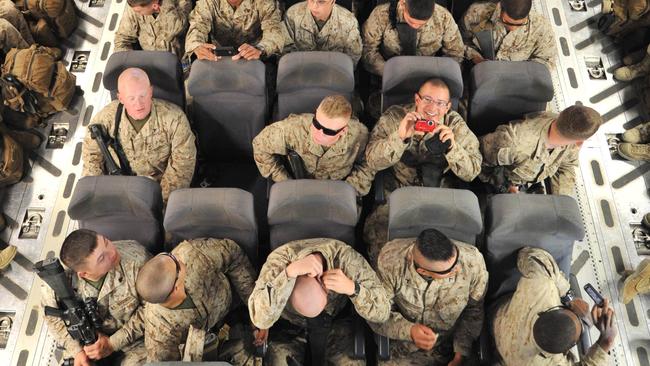
On Monday, as the latest round of UN-brokered Syria peace talks got under way in Geneva, Russian President Vladimir Putin, flanked by Defence Minister Sergei Shoigu and Foreign Minister Sergei Lavrov, announced that Russia’s mission in Syria had been accomplished and that the “main force” would begin pulling out. Within 24 hours the first aircraft and troops began returning to Russian-occupied Crimea.
Russia has been a close ally of the Syrian regime since the 1970s and offered covert assistance to Bashar al-Assad as soon as the war began in 2011. But the Kremlin’s overt intervention began only 5½ months ago, on September 30, when Russian ships, aircraft and marines were deployed in Syria with the stated goals of “stabilising the legitimate power” (the Assad regime) and “creating the conditions for political compromise”.
Equally important (though unstated) objectives were to create a buffer zone around Russia’s base at Tartus (the Russian Federation’s only warm-water port in the Mediterranean, and its only naval base anywhere outside the former Soviet Union), and demonstrate new capabilities — precision munitions, cruise missiles, advanced aircraft, drones, tanks and surface-to-air weapons — achieved under Russia’s military modernisation program since 2011. Politically, Putin’s goals were to emphasise the Kremlin’s return as a player in Middle East politics, demonstrate military prowess, change the calculus for the US and deflect attention from the bloody, stalemated conflict in Ukraine.
Russia has achieved these goals, though not without losses.
Mid last year, after a string of defeats including the fall of Palmyra to Islamic State, Assad’s government was in free fall. The regime was losing control of al-Ghab plain (Syria’s breadbasket) and key oil, gas and water reserves, and being forced out of the northern province of Idlib and the southern region around Deraa and Quneitra.
Syrian conscripts, Hezbollah fighters from Lebanon and Iranian Revolutionary Guard “volunteers” had suffered heavy losses trying to hold the line, while Assad’s control of the Alawite hills and the Homs-Hama corridor (the regime’s heartland) and the coastal strip around the vital port city of Latakia was increasingly shaky. A diverse rebel movement — Kurdish separatists, Western-backed moderates, Islamists supported by the region’s Sunni states, and jihadists such as Islamic State and Jabhat al-Nusra, also known as al-Nusra Front, threatened the government’s survival.
Six months and 9000 Russian airstrikes later, the picture looks very different. After initially stabilising Latakia and the coastal strip, Russian airstrikes and ship-launched cruise missiles helped Syrian forces — with support from Iranian ground troops and Hezbollah fighters — roll back the rebels in Idlib, regain parts of al-Ghab, and launch offensives south and north of Aleppo, Syria’s second city and most important northern centre.
From a narrow, shrinking coastal strip last year, the regime’s control now extends across the entire western third of Syria: not victory, by any means, but a far cry from its near-death experience.
To enable this success, Russian aircraft mounted an average of 54 airstrikes each day, surging to two or three times that number during key battles, allowing the regime to capture more than 400 rebel-held settlements across 10,000sq km.
Russian operations were characteristically heavy-handed, striking civilian settlements as often as military targets and killing at least 1000 civilians, including 200 children. Russian aircraft employed air-delivered cluster bombs banned under the 2008 Oslo Convention on Cluster Munitions — to which Russia, like the US, is not a signatory. And Russia’s targeting of “terrorist groups” — as Russian defence spokesmen described them — seemed to include more moderate secular nationalists than Islamist extremists.
In part, the civilian deaths were evidence of lack of Russian practice in precision strike operations; mostly, however, they revealed a different attitude to the civil population than the US-led coalition.
Whereas the coalition regards civilians as innocent bystanders or hostages held against their will (and is careful, to a fault, in avoiding civilian casualties) the Russians — like Assad — often see the population in rebel-controlled areas as part of the problem: as actual or potential rebels, and hence as legitimate targets.
Likewise, whereas the US-led coalition is intervening against jihadist groups such as Islamic State, Russia intervened in support of Assad, so its strikes tended to focus on rebel groups that most directly threatened the regime, rather than those with the most extreme ideology.
Despite (or perhaps because of) this heavy-handedness, Russia’s intervention has not been without losses. The most severe was the downing of a Russian civilian airliner over Sinai on October 31, a month into the intervention, which killed 224 people and was attributed to an Islamic State affiliate that subsequently claimed the attack as retaliation for Russian strikes in Syria.
Even more serious, in geopolitical terms, was Turkey’s downing of a Sukhoi-24 strike aircraft that penetrated its airspace, after repeated warnings to change course, on November 24. A Turkish Air Force F-16 fighter shot down the Sukhoi, which crashed in Syria, where pilot Oleg Peshkov was killed by ground fire from Turkish-backed rebels while descending by parachute. Peshkov’s weapons officer, Konstantin Murakhtin, was rescued by marines from the Russian air base at Khmeimim, though a rescuer, Aleksandr Pozynich, was killed in the attempt.
Peshkov, Murakhtin and Pozynich have been honoured as heroes in Russia, but the incident created a spike in Russia-NATO tensions and prompted Russia to deploy ships with sophisticated air defence systems to sit offshore near Khmeimim. Further incidents occurred between Russian and Turkish aircraft in the north, and Russian planes also seem to have reconnoitred Syria’s southern border but thought better of testing its limits after encountering Israeli and Jordanian aircraft.
Despite these losses and the increased tensions that came with them, Putin’s first objective — to stabilise the Assad regime — clearly has been achieved. By February 26 the regime was confident enough of its long-term survival to agree to a cessation of hostilities, enabling the present round of talks on Syria to go ahead in Geneva. Putin’s second objective — to create conditions for a peaceful settlement — depends on what happens now in Geneva.
In that context, Russia’s partial withdrawal can be seen as a message to Assad: “We’ve stabilised your regime, now negotiate peace.” By emphasising that Russian forces will not stick around forever to prop him up, Putin is putting pressure on Assad to reach a compromise with rebel negotiators in Geneva.
Such a compromise almost certainly will result in Assad eventually stepping down. Negotiations previously have foundered on this point, with the US and Turkey insisting Assad go now, and Russia and Iran arguing that Assad needs to stay through any power-sharing arrangement — though leaving open the possibility that he might step down after a popular vote at the end of a transition period of up to 18 months.
Syrian peace activists have emphasised the need to draw a distinction between Assad the man, on the one hand, and the Syrian government on the other. However bad Assad may be — and he is very bad; even leaving aside the horrendous use of chemical weapons against its own population, at this point his regime has killed about nine times as many Syrians as Islamic State — a state of anarchy would be even more lethal, in their view, and might result in an outright takeover by Islamic State or al-Qa’ida-linked groups.
But in the present round of talks, negotiators seem less focused on longer-term issues such as any future transition of power, and more on extending the partial ceasefire. So far, disputes in Geneva have been about the shape of a post-conflict Syrian state, with Kurdish delegates calling for a federal structure and the High Negotiations Committee (which represents the main rebel groups) opposing the presence of the Moscow Group, an opposition coalition tolerated by Assad.
By all accounts Russian negotiators have played a positive role in the talks so far, encouraging regime representatives to engage constructively — something Russian diplomats arguably can do only because of the leverage military intervention has given them.
Russia’s redeployment also raises some rather obvious questions for Western countries.
The first is whether the pullout is genuine — and so far it’s a little hard to tell. Russia still maintains its naval base at Tartus, of course, and the newly expanded air bases at Bassel al-Assad (near Khmeimim on the coastal strip) remain operational. Russian warplanes are still flying over Syria, only about 10 aircraft have redeployed so far, and it’s possible the withdrawal could turn out to be more show than substance.
It also remains to be seen whether the Russian move is less of a withdrawal and more of a repositioning of assets from Syria into Ukraine ahead of a possible springtime surge in activity there.
A second question is how the Russian deployment has altered the power dynamic in the Middle East. Countries such as Jordan and Israel — traditional US allies — have found themselves having to co-ordinate with the Russians to avoid incidents, while the Russian-led operations cell in Baghdad has brought the Iraqi government together with Syrians, Iranians, Russians and representatives of Hezbollah into a co-ordinated targeting system that excludes the West.
Russia’s military engagement has given it much greater leverage in the region and underlined Putin’s breakout from the post-Cold War system of US-dominated alliances in the Middle East. We can expect Russia to remain an influential player in the region for the foreseeable future.
Finally, Russia’s withdrawal — no less than its original intervention last September — seems to have caught Washington by surprise. Pentagon officials say they are still analysing the Russian move to determine its impact, but the implication is that Russia has avoided the quagmire that US President Barack Obama confidently predicted as recently as last week.
To the extent that Russia does succeed in avoiding a Middle East morass, it’s clear that the specific, limited military objectives that guided the intervention — underpinned by a very clear set of political goals laid down by Putin — have helped to achieve this.
Despite the partial Russian pullout, it’s clear Russian troops, Russian advisers and a limited number of aircraft and ships will remain in Syria for the foreseeable future, and Russia will continue to play a role in any potential future peace settlement. The good news is that such a settlement appears closer now — with the cessation of hostilities agreement, and the resumption of peace talks — than at any time since well before the Russian intervention. The bad news is that peace is still a long way off, the most violent extremist groups in Syria are not a party to the talks, and even if a settlement were magically achieved tonight, Syria would still require 10 or 20 years of extensive reconstruction, peacekeeping and stabilisation efforts just to partially repair the damage done by five years of war.
“Creating the conditions for political compromise”, to use Putin’s phrase, is an essential first step in that process, but the ultimate outcome remains as difficult (and almost as elusive) as ever.







To join the conversation, please log in. Don't have an account? Register
Join the conversation, you are commenting as Logout